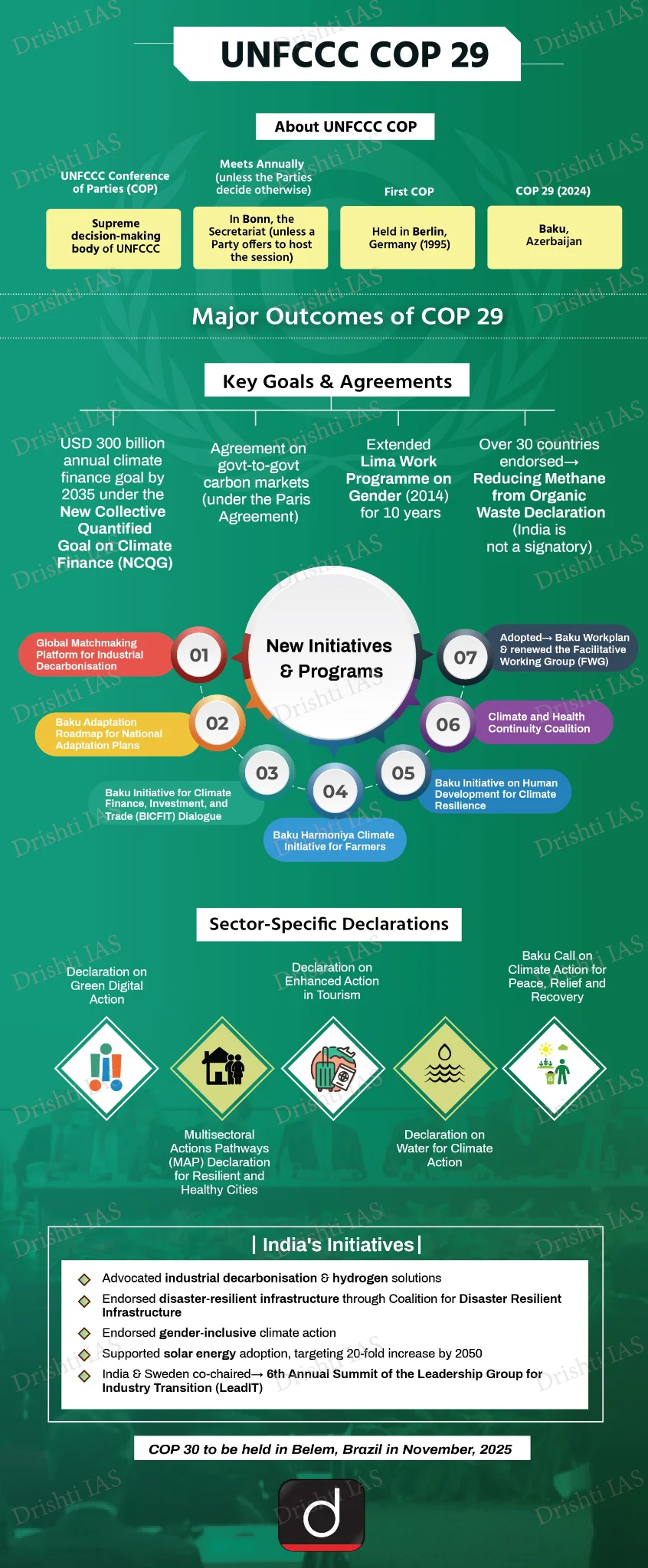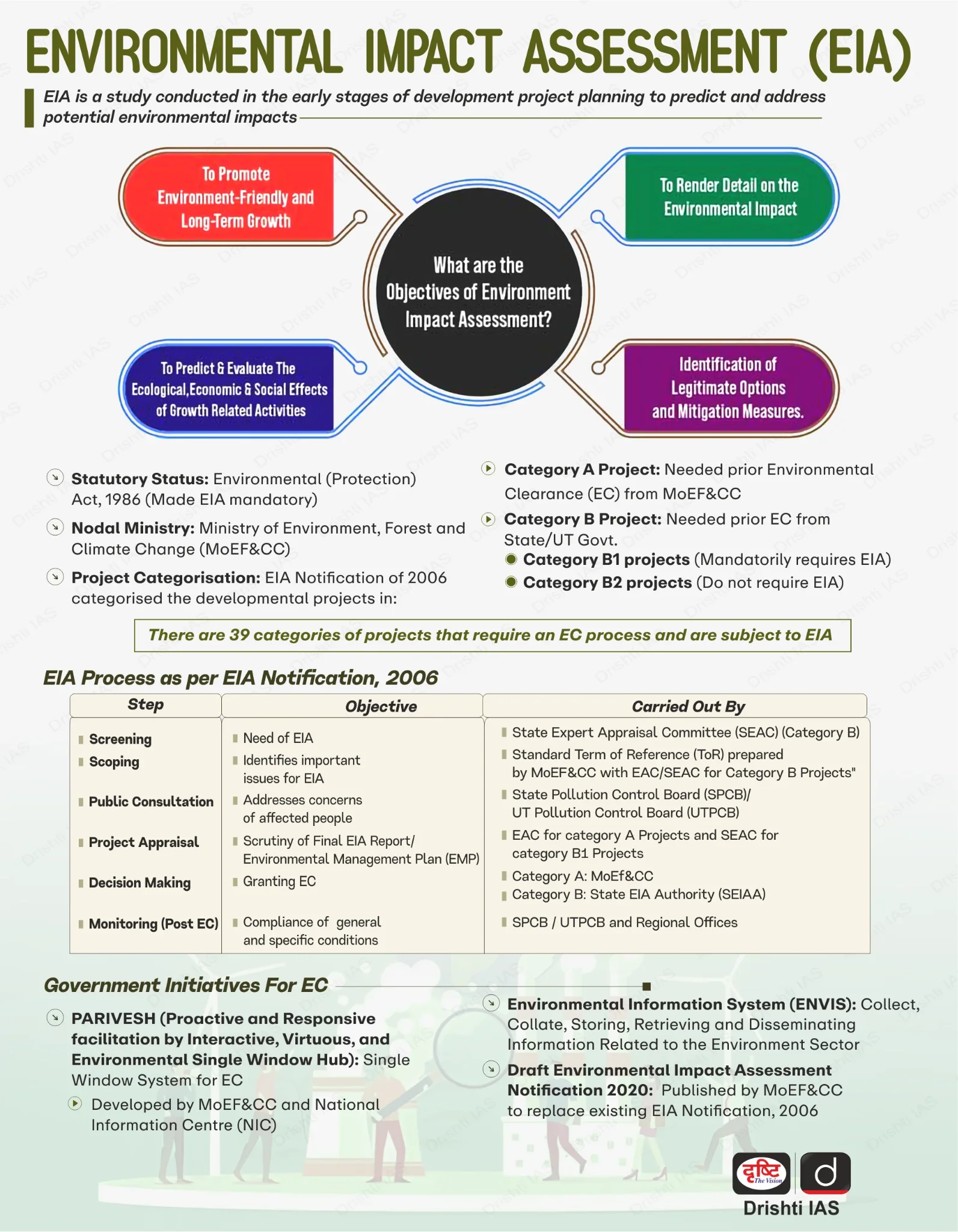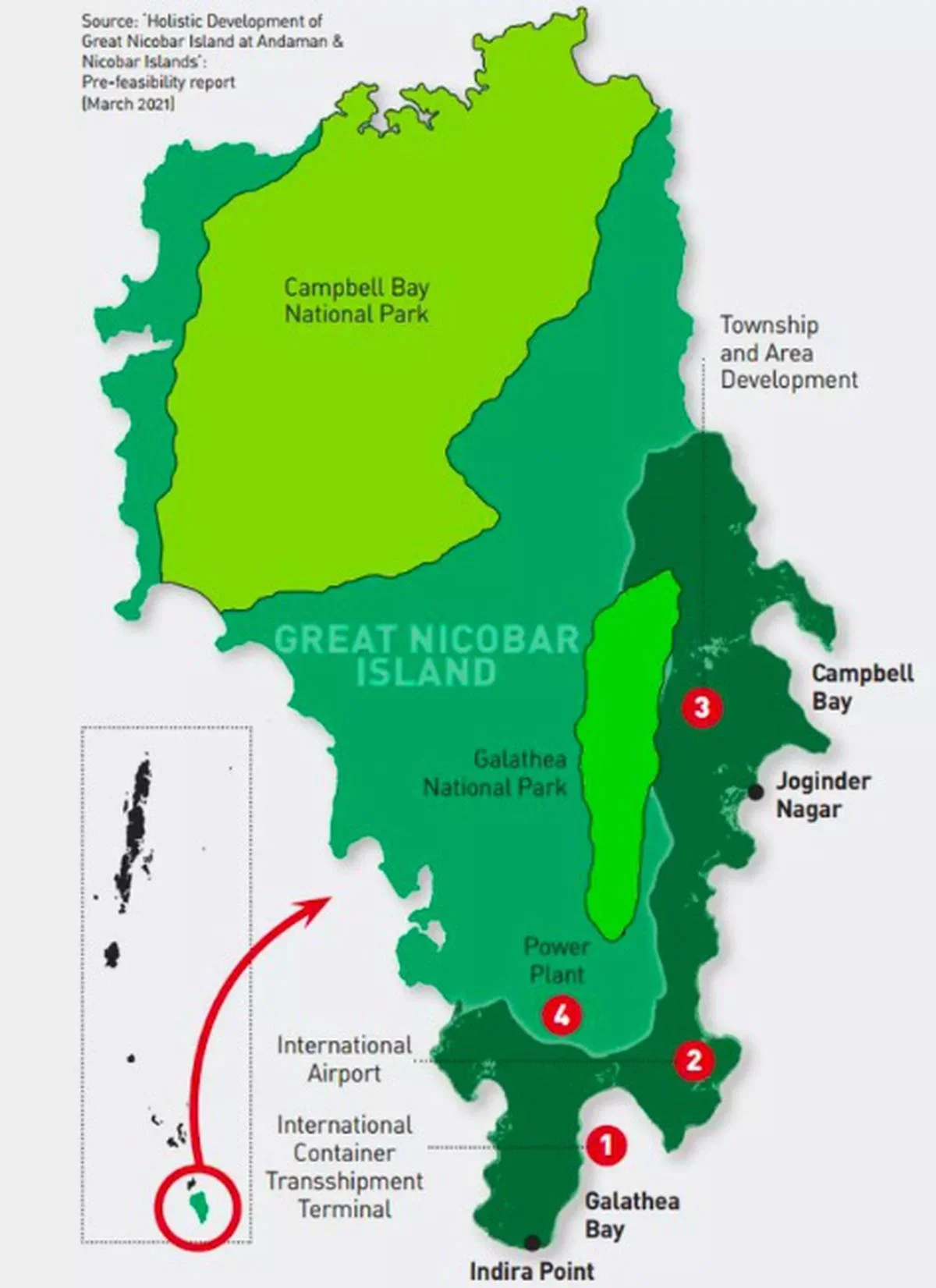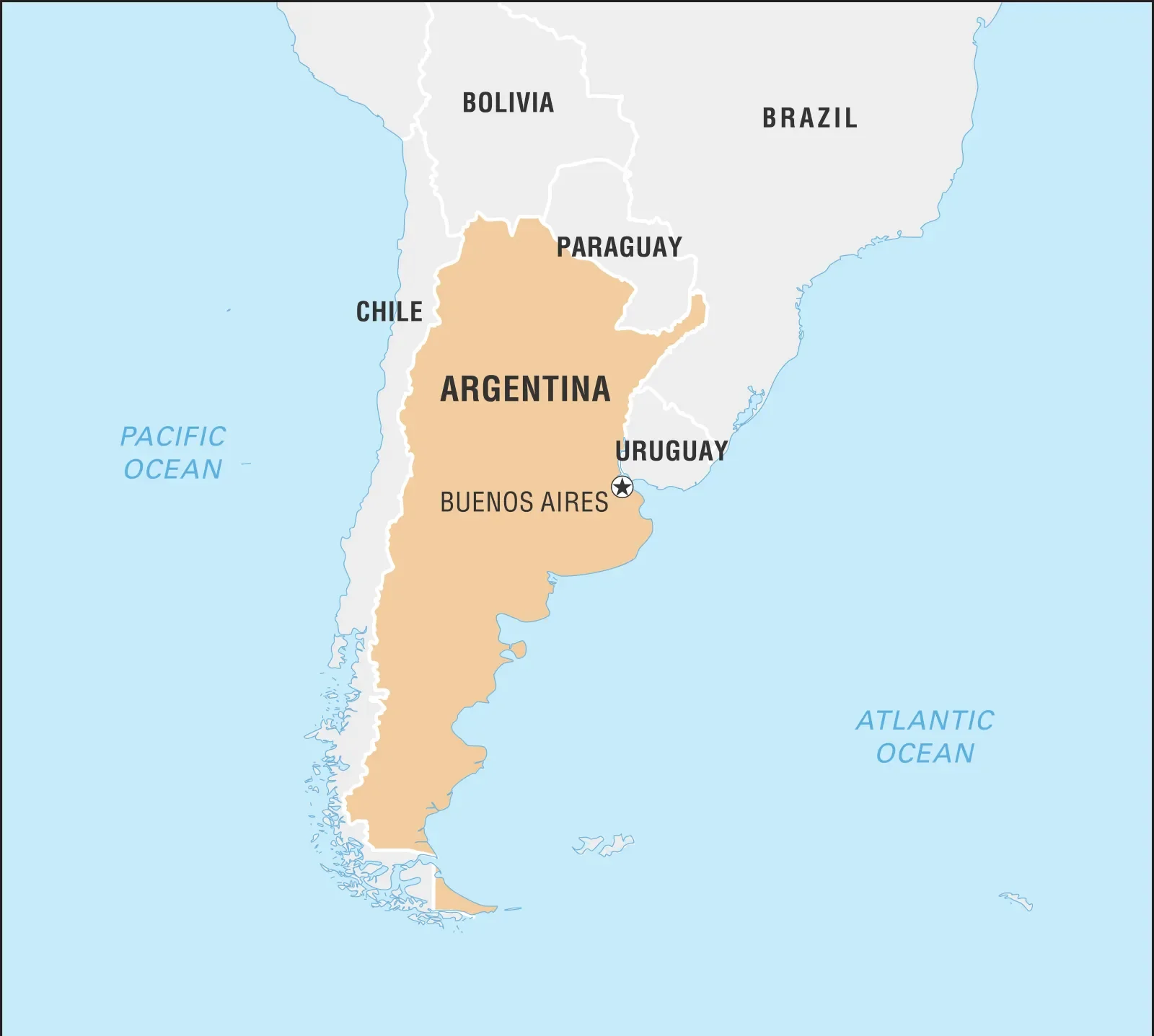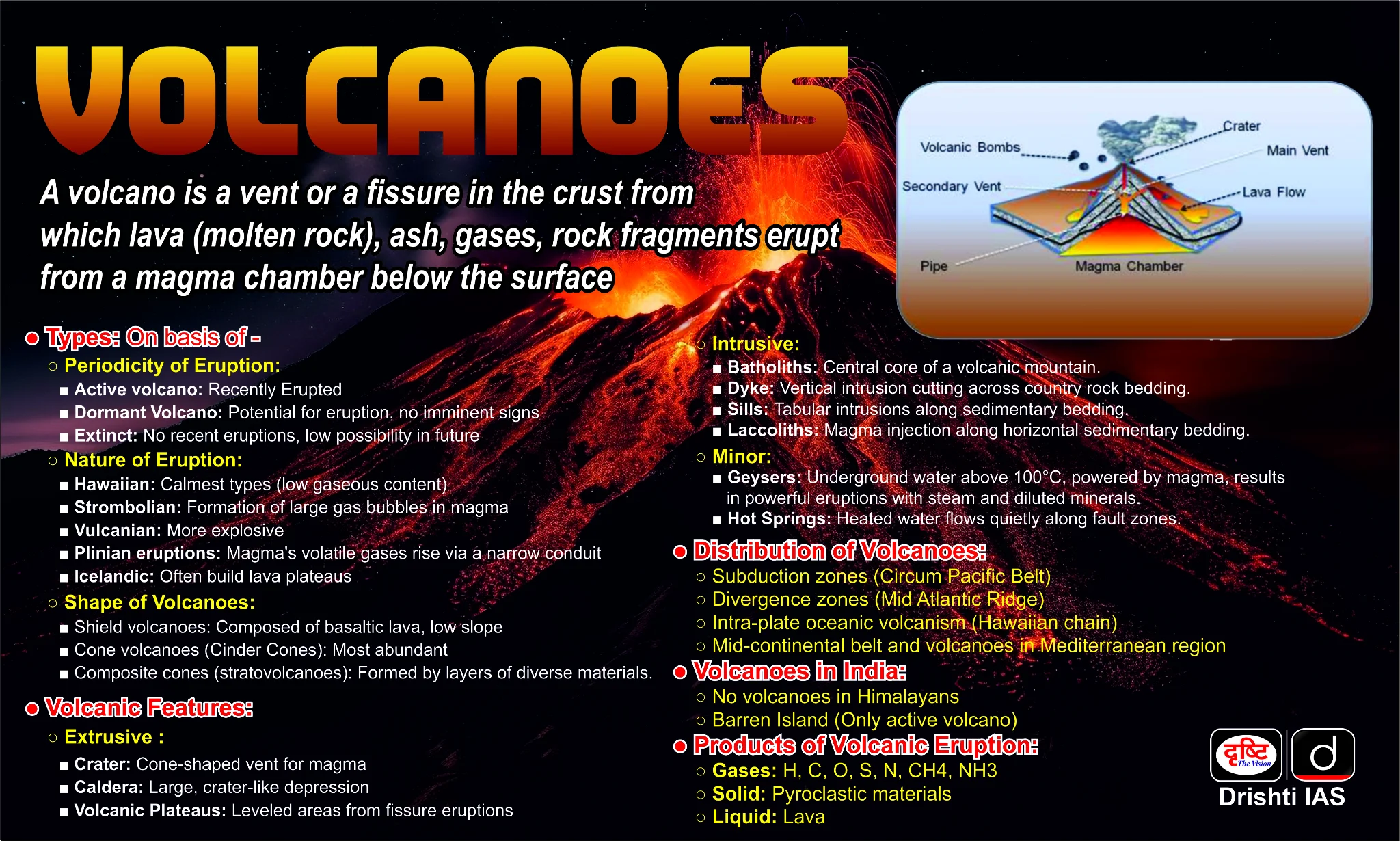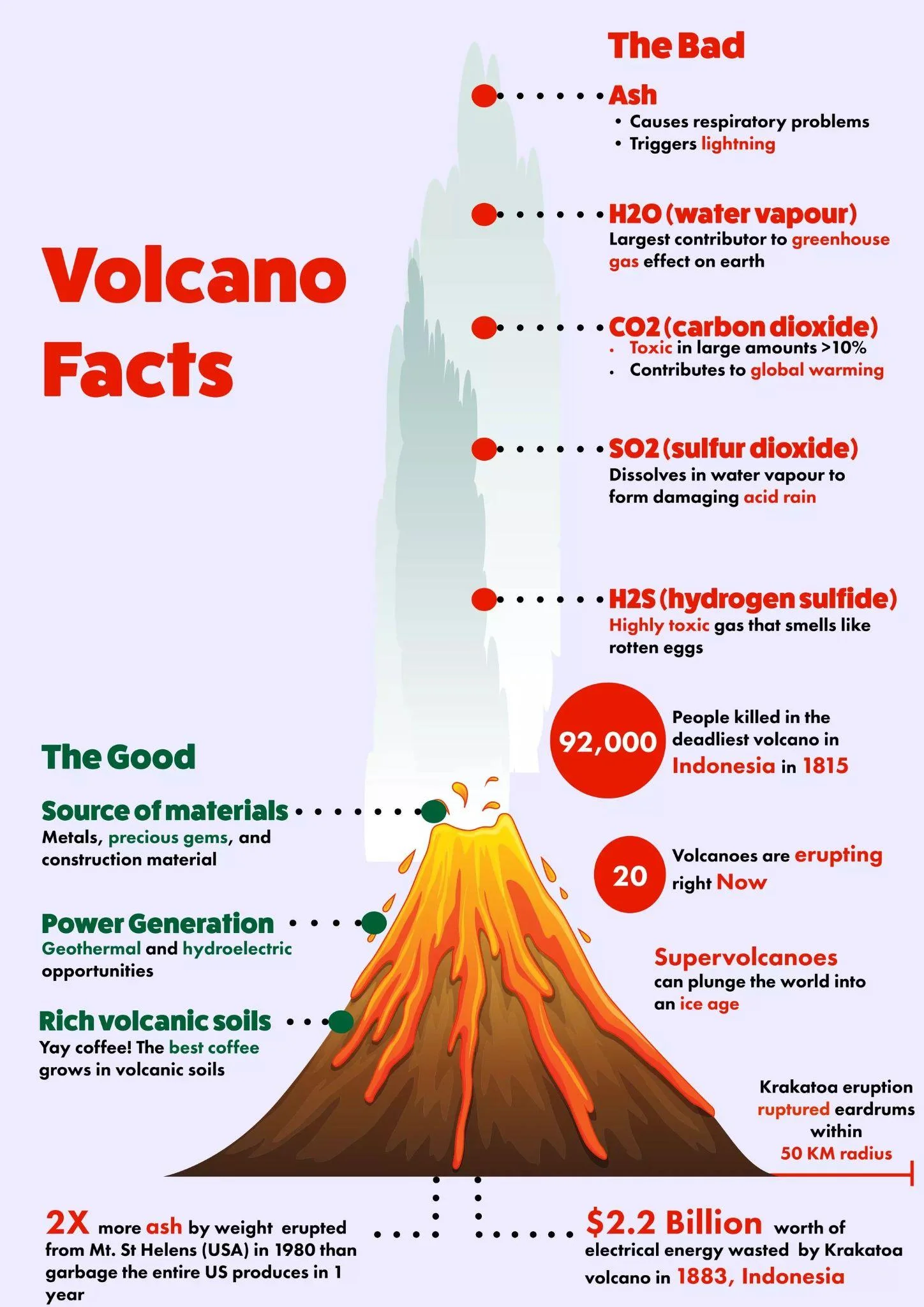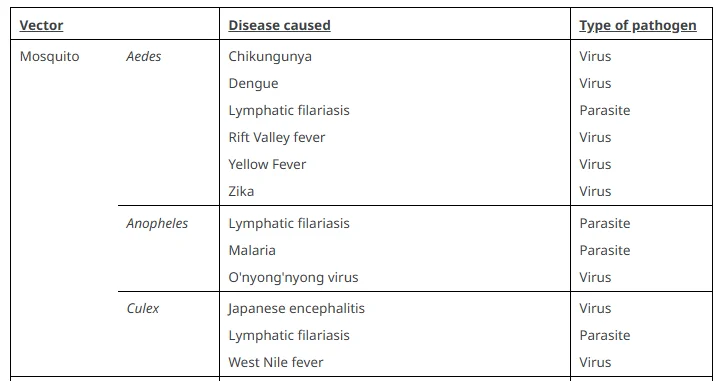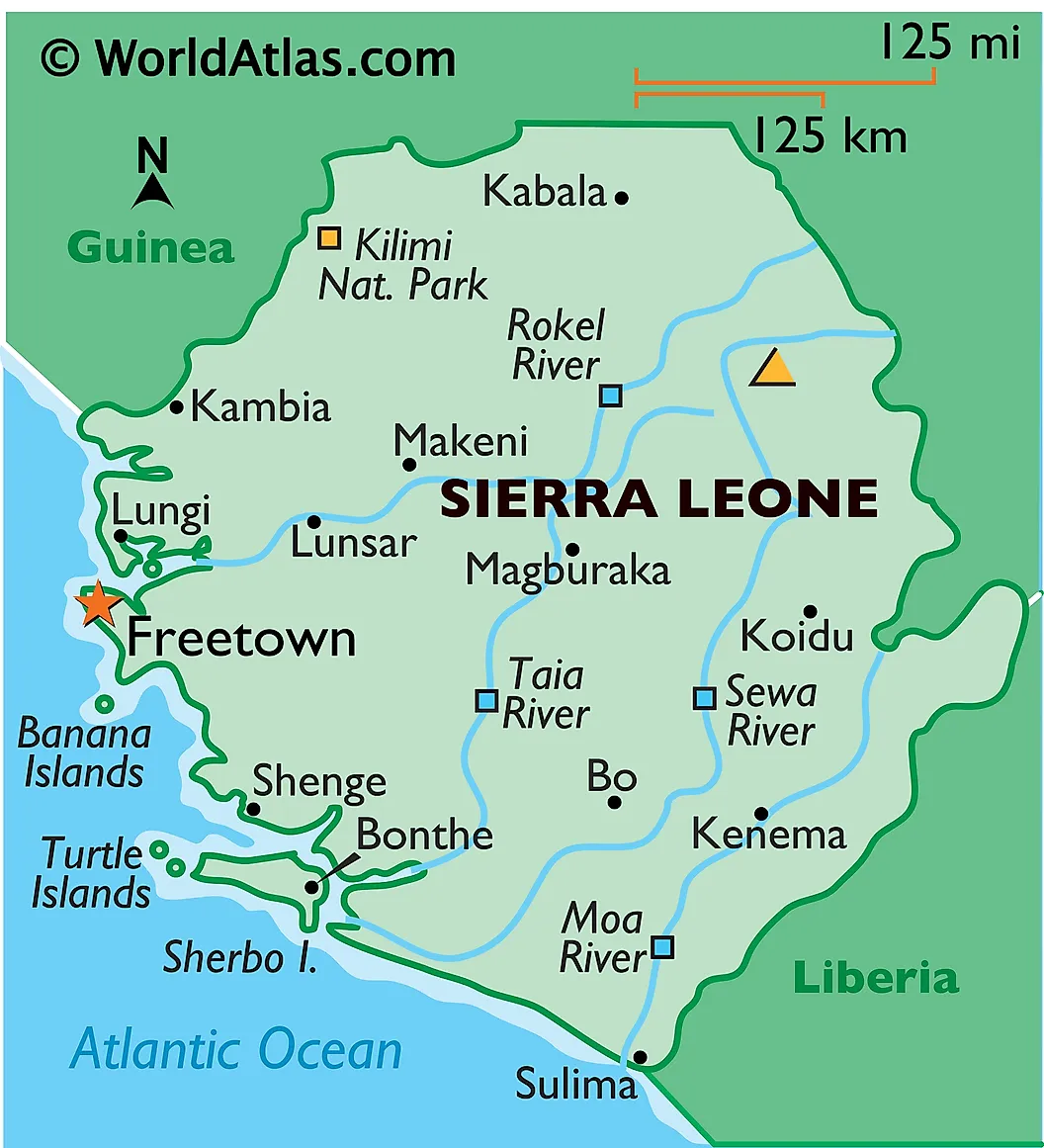Biodiversity & Environment
Call for Reforming the UNFCCC
For Prelims: UNFCCC, Convention on Biological Diversity, Green Climate Fund, Kyoto Protocol, Adaptation and Mitigation
For Mains: Role of UNFCCC in Global Climate Governance, Structural Reform Proposals for International Climate Institutions
Why in News?
A renewed push to reform the United Nations Framework Convention on Climate Change (UNFCCC) process has gained traction ahead of 30th Conference of the Parties (COP) in Brazil (2025), amid concerns over its weak implementation, insufficient finance, and procedural inefficiencies.
- Though proposals were discussed at the 2025 Bonn Conference, no consensus was reached.
What is the Need for Reform in the UNFCCC Process?
- Lack of Effectiveness: Despite decades of negotiations, global emissions continue to rise, and the process has not delivered the scale of action needed to limit warming to 1.5°C.
- Voluntary Commitments: The Paris Agreement relies on nationally determined contributions (NDCs), which are not legally binding and often fall short of scientific recommendations.
- As of May 2025, only 21 countries (around 11%) have submitted their 2035 NDCs, raising concerns ahead of COP30 in Brazil.
- Even among those submitted, many lacked credible implementation plans (meaning they were ambitious on paper but vague or underfunded in practice).
- Consensus-Based Decision-Making: Every decision under the UNFCCC must be agreed upon by all parties, giving each country effective veto power.
- This often leads to watered-down agreements to achieve consensus.
- Civil society groups have called for majority-based decision-making when consensus is elusive, but this remains controversial.
- Inequity and Climate Justice Concerns: Small island states and least developed countries often feel sidelined, with their calls for climate justice and adaptation finance inadequately addressed.
- The failure of developed countries to meet their climate finance commitments and emission reduction targets has deepened mistrust.
- Small Island Developing States (SIDS), despite contributing less than 1% of global emissions, face severe climate impacts.
- Under a 2°C warming scenario, annual losses from extreme weather could reach USD 75 billion by 2050.
- Credibility and Political Will: The US withdrawal from the Paris Agreement has undermined the credibility of the UNFCCC..
- Implementation Gaps: The Kyoto Protocol faced major shortcomings as it exempted developing countries like China and India, weakening global emission reduction efforts. It led to a significant rise in global emissions, 44% increase by 2012 from 1997 levels.
- The Paris Agreement, though more inclusive, suffers from absence of enforceable timelines.
- The Loss and Damage Fund, meant to support vulnerable countries, remains underfunded, with developed nations showing reluctance to accept liability.
- COP28 (Dubai) lacked a clear timeline, binding mandates, and enforceable commitments to bridge the climate finance gap.
- Fossil Fuel Influence: COP28 marked the first agreement acknowledging the need to transition away from fossil fuels. However, hosting COP meetings in countries heavily dependent on fossil fuels such as Dubai and Baku has raised concerns over conflicts of interest and greenwashing.
- Insufficient Enforcement Mechanisms: Countries face no real consequences for failing to meet their commitments, which weakens accountability and undermines trust in the system.
What is the UNFCCC?
- About: The UNFCCC was adopted at the 1992 Rio Earth Summit and entered into force on 21st March 1994.
- As of now, the Convention has 198 Parties, making it nearly universal in membership.
- UNFCCC is one of the three Rio Conventions along with Convention on Biological Diversity (CBD), and the United Nations convention to combat Desertification (UNCCD).
- These conventions are interconnected and supported by the Joint Liaison Group to ensure synergies in addressing global environmental challenges.
- Objective: To stabilize greenhouse gas concentrations in the atmosphere at a level that would prevent dangerous human interference with the climate system.
- Core Principles:
- Common but Differentiated Responsibilities (CBDR): Developed countries, having contributed more historically to emissions, are expected to take the lead in reducing them and supporting developing nations.
- Equity: Recognizes the different capabilities and responsibilities of individual countries.
- Institutional Structure
- COP: Supreme decision-making body.
- Subsidiary Bodies: Includes the Subsidiary Body for Scientific and Technological Advice (SBSTA) and the Subsidiary Body for Implementation (SBI).
- Secretariat: Based in Bonn, Germany, it supports the implementation of the Convention and its protocols.
- Global Innovation Hub: Launched in 2021, aims to promote transformative innovations for a low-emission and climate-resilient future.
- Key Functions
- Negotiation Platform: Hosts annual Conferences of the Parties (COPs), where countries negotiate climate agreements and review progress.
- Monitoring and Reporting: Requires countries to submit regular reports on their emissions and climate actions.
- Financial and Technical Support: Facilitates funding and technology transfer to developing countries through mechanisms like the Green Climate Fund.
- Major Agreements Under the UNFCCC:
- The Kyoto Protocol, adopted in 1997, is the only global treaty with legally binding targets for developed countries to cut greenhouse gas emissions. It aimed to reduce emissions by 5% below 1990 levels by 2012.
- India ratified it in 2002. It follows the principle of “common but differentiated responsibilities.
- Paris Agreement (2015) countries agreed to submit voluntary climate action plans (NDCs) to limit global warming to well below 2°C, ideally 1.5°C.
- The Kyoto Protocol, adopted in 1997, is the only global treaty with legally binding targets for developed countries to cut greenhouse gas emissions. It aimed to reduce emissions by 5% below 1990 levels by 2012.
What Reforms can be Adopted to Enhance the Effectiveness of the UNFCCC Process?
- Proposal for Majority-Based Decision Making: Permit majority voting when consensus fails after a defined negotiation period. This would prevent obstruction by a few states and enable more ambitious outcomes.
- Mandate Independent Review of NDC Implementation: Create an independent technical body under the UNFCCC to assess NDC credibility, track implementation, and publicly flag underperformance.
- This would introduce reputational accountability and technical rigor into the process.
- Tie Climate Finance Access to Transparency and Results: Link disbursement of funds (e.g. from the Green Climate Fund) to transparent reporting and measurable progress on adaptation and mitigation.
- These reforms address structural inefficiencies and political bottlenecks in the UNFCCC process and, if implemented, could greatly improve its credibility, equity, and effectiveness.
- Reframe Negotiations Around Human Needs: Encourage shifting climate negotiations to a human needs-based framework, focusing on low-carbon solutions for housing, food, health, and mobility.
- Backed by the UNFCCC’s Global Innovation Hub, this approach aligns climate action with development justice and helps engage more developing countries.
- Negotiations are hindered by bloated agendas and lengthy statements. Streamlining agenda items, capping delegation sizes, and limiting speaking times can enhance efficiency in the UNFCCC process.
Conclusion
The proposals for UNFCCC reform reflect growing frustration among developing countries and civil society groups. The need for greater efficiency, accountability, and adequate climate financing is evident, making COP30 a crucial platform to address these concerns. Strengthening the UNFCCC process through these reforms would enhance global cooperation and accountability essential for effectively tackling the climate crisis.
|
Drishti Mains Question: Despite near-universal participation, the UNFCCC is increasingly criticized for its lack of effectiveness and equity. Examine the structural issues and suggest reforms to make it more responsive to the climate emergency. |
UPSC Civil Services Examination, Previous Year Questions
Mains
Q. Describe the major outcomes of the 26th session of the Conference of the Parties (COP) to the United Nations Framework Convention on Climate Change (UNFCCC). What are the commitments made by India in this conference? (2021)


Biodiversity & Environment
Great Nicobar Project EIA Downplays Earthquake Risk
For Prelims: Great Nicobar Infrastructure Project (GNIP), Environment Impact Assessment (EIA), Earthquake, Plate Boundary, Sunda Trench, Pacific Ring of Fire, Tropical Rainforest, Leatherback Sea Turtles, Galathea Bay Wildlife Sanctuary, Shompen, Malacca, International Container Transshipment Terminal (ICTT).
For Mains: Great Nicobar Island (GNI) project and its significance, Concerns associated with GNIP steps needed to address these concerns.
Why in News?
The proposed Rs 72,000-crore Great Nicobar Infrastructure Project (GNIP) has sparked concerns, as an IIT-Kanpur report highlighted safety risks associated with the region’s status as a highly seismic zone, which was hit by a devastating tsunami in 2004.
What are the Key Findings of IIT-Kanpur Report that Highlighted the Vulnerabilities of the Great Nicobar Project?
- Potential for Future Mega Earthquake: It estimates a ‘return period’ of 420–750 years for mega-earthquakes (magnitude of 9 or more) and 80–120 years for large-magnitude earthquakes (>7.5), indicating high seismic vulnerability.
- However, the Environmental Impact Assessment (EIA) report states that the likelihood of a mega-earthquake (similar to the 2004 9.1-magnitude quake) is low.
- Geological Evidence of Past Tsunamis: Sediment analysis from Badabalu beach in South Andaman revealed evidence of at least seven large tsunami events over the past 8,000 years, pointing to a long history of major seismic activity in the region.
- Need for Site-Specific Studies: Site-specific seismic and tsunami studies must be conducted in Nicobar Islands, especially in areas like Car Nicobar and Campbell Bay, which are lacking such assessments.
What is the Great Nicobar Island Project?
- About: Launched in 2021, GNIP is a mega infrastructure initiative to be implemented on Great Nicobar Island (GNI), located at the southern end of the Andaman and Nicobar Islands.
- Features: Spearheaded by NITI Aayog, it includes a transshipment terminal at Galathea Bay, a greenfield airport, a greenfield township, and a tourism project with a gas-powered plant.
- It is being executed by the Andaman and Nicobar Islands Integrated Development Corporation (ANIIDCO) and is strategically located near the Malacca Strait, a key maritime route linking the Indian Ocean to the Pacific Ocean.
- Significance:
- Strategic Importance: Nicobar’s strategic location near the Malacca, Sunda, and Lombok Straits enables India to monitor crucial sea routes vital for global trade and energy supply, aligning with the Act East Policy (2014) and the QUAD’s Indo-Pacific strategy.
- The planned greenfield airport will enhance defense deployment, boosting India’s capacity to track Chinese naval movements and reinforce regional security.
- Economic Significance: The International Container Transshipment Terminal (ICTT) aims to reduce India’s dependence on foreign ports like Singapore and Colombo.
- It forms a key part of the Maritime India Vision 2030 and Amrit Kaal Vision 2047, aligning with India’s long-term economic strategy.
- Strategic Importance: Nicobar’s strategic location near the Malacca, Sunda, and Lombok Straits enables India to monitor crucial sea routes vital for global trade and energy supply, aligning with the Act East Policy (2014) and the QUAD’s Indo-Pacific strategy.
Great Nicobar Island
- About: Great Nicobar is the southernmost and largest island of the Nicobar group in the southeastern Bay of Bengal, and is mostly covered in tropical rainforest.
- Indira Point, situated on Great Nicobar Island, is the southernmost point of India.
- Geographical Division: The Andaman and Nicobar Islands comprise 836 islands, divided into Andaman (north) and Nicobar (south), separated by the 150-km-wide 10° Channel.
- Ecological Importance: Great Nicobar island is home to two national parks—Campbell Bay National Park and Galathea National Park and a biosphere reserve, the Great Nicobar Biosphere Reserve.
- Tribes: It is inhabited by small populations of indigenous tribes, including the Shompen, Onge, Andamanese, and Nicobarese.
What Concerns Are Associated with the Great Nicobar Island Project?
- Environmental Concerns:
- Rampant Deforestation: The project will clear 130 sq km of primary tropical rainforest, causing biodiversity loss, with actual tree felling possibly exceeding 10 million, far above initial estimates of 8.65–9.64 lakh.
- Wildlife Disruption: The project threatens leatherback sea turtles in the Galathea Bay Wildlife Sanctuary, designated in 1997 for their conservation, was denotified in 2021 for the port—contradicting India’s Marine Turtle Action Plan (2021).
- The coastline is classified as Coastal Regulation Zone (CRZ 1A), where ship-repair and other industrial activities pose a significant threat to marine ecosystems.
- Compensatory Afforestation Issues: The diversion of pristine Nicobar forests is being “compensated” with land in Haryana and Madhya Pradesh, which fails to replicate the lost biodiversity.
- Geological Concerns: The island's tertiary sandstone, limestone, and shale over volcanic rocks amplify seismic shaking and are prone to liquefaction during earthquakes.
- Legal Concerns: The SC appointed Shekhar Singh Commission 2002 recommended a total ban on tree felling in tribal reserves and national parks, along with afforestation before felling—a rule currently not being followed.
- The project's environmental clearance, justified by national security, is contested due to lack of consultation and transparency, and its potential to harm the Shompen tribe by endangering their forest-based livelihood.
Note: CRZ 1A, under the Coastal Zone Management Plan 2019, covers ecologically sensitive coastal areas like coral reefs, crucial for biodiversity and ecosystem stability.
What Measures can be Adopted to Ensure the Sustainability of the Great Nicobar Island Project?
- Safeguarding Ecological Integrity: Conduct a comprehensive biodiversity assessment to identify critical habitats and explore alternative sites for infrastructure development, ensuring full compliance with environmental laws.
- Additionally, prioritize the restoration of degraded forests across the Andaman and Nicobar Islands to maintain ecological balance.
- Ensuring Indigenous Rights and Inclusion: Minimize the displacement of indigenous communities like the Shompens and Nicobarese, ensure fair compensation, provide livelihood support and skill development, and establish a community council to ensure inclusive and participatory decision-making.
- Enhancing Institutional Transparency: Establish an independent monitoring body including environmentalists, local representatives, and government officials to ensure compliance with safeguards, maintain transparency, and uphold accountability throughout project implementation.
- Resilient and Sustainable Resource Use: Promote sustainable management of water, food, and energy resources, while strengthening climate-resilient infrastructure and enhancing the region’s disaster preparedness to reduce future vulnerabilities.
Conclusion
The Great Nicobar Project, while strategically significant, faces critical ecological and seismic risks. A balanced approach—incorporating rigorous scientific assessments, protecting biodiversity, respecting tribal rights, and ensuring disaster-resilient infrastructure—is essential. Sustainable development must prioritize long-term environmental security alongside economic and strategic goals to avoid irreversible damage to this fragile island ecosystem.
|
Drishti Mains Question: Evaluate the strategic and environmental implications of the Great Nicobar Infrastructure Project. |
UPSC Civil Services Examination, Previous Year Question (PYQ)
Prelims
Q. Consider the following statements: (2018)
- The Barren Island volcano is an active volcano located in the Indian territory.
- Barren Island lies about 140 km east of Great Nicobar.
- The last time the Barren Island volcano erupted was in 1991 and it has remained inactive since then.
Which of the statements given above is/are correct?
(a) 1 only
(b) 2 and 3
(c) 3 only
(d) 1 and 3
Ans: (a)
Q. Which one of the following pairs of islands is separated from each other by the ‘Ten Degree Channel’? (2014)
(a) Andaman and Nicobar
(b) Nicobar and Sumatra
(c) Maldives and Lakshadweep
(d) Sumatra and Java
Ans: (a)
Mains
Q. Project ‘Mausam’ is considered a unique foreign policy initiative of Indian government to improve relationship with its neighbours. Does the project have a strategic dimension? Discuss. (2015)


International Relations
India-Argentina Relations
For Prelims:17th BRICS Summit, Argentina, India-Argentina Business Council (IABC), India–MERCOSUR Preferential Trade Agreement (PTA), Lithium, Free Trade Agreement (FTA).
For Mains: India- Argentina Relations, India’s Relation with Latin America: Prospects & Challenges
Why in News?
The Prime Minister of India visited Argentina for the first time in 57 years, commemorating 75 years of diplomatic relations and 5 years of Strategic Partnership.
- He was awarded the "Key to the City of Buenos Aires," recognizing India's growing global prominence and the strengthening of bilateral ties.
Argentina
- Capital: Buenos Aires
- Location: Southern South America, 8th largest country (area wise) globally and 2nd largest in South America (after Brazil).
- It borders Chile (W/S), Bolivia & Paraguay (N), Brazil (NE), Uruguay & Atlantic Ocean (E).
- Topography: Divided into 4 key regions- Andes Mountains (with highest peak Cerro Aconcagua), Northern region, Pampas (agricultural heartland), and Patagonia (south).
- Economy: Resource-rich, industrialized economy with a skilled workforce; among South America’s largest economies.
What are the Key Highlights of the PM's State Visit to Argentina?
- Strategic and Economic Engagement: India and Argentina agreed to expand India–MERCOSUR Preferential Trade Agreement (PTA) to boost bilateral trade and economic ties.
- Focus areas include trade diversification, reducing reliance on primary commodities, and enhancing investment in emerging sectors.
- Energy Security and Critical Mineral Cooperation: Both nations committed to shale energy collaboration, leveraging Argentina’s 2nd largest shale gas and 4th largest shale oil reserves.
- India also signalled interest in expanding oil & gas cooperation under the ONGC Videsh & Argentina's state-owned energy company YPF, to support its growing energy needs.
- Defence & Digital Cooperation: India and Argentina agreed to boost defence manufacturing via co-development and tech transfer, and expand adoption of India’s Digital Public Infrastructure like UPI, telemedicine, and digital health, enhancing strategic and tech partnerships.
- Shared Democratic Values & Soft Power Diplomacy: Both leaders reaffirmed commitment to democratic values, South-South cooperation, and multilateralism.
- PM’s visit to General San Martín’s (Argentinian statesman national hero) statue symbolised strong people-to-people ties and India’s rising soft power in Latin America.
What are Key Areas of Cooperation Between India & Argentina?
- Political Relations: India established an embassy in Buenos Aires in 1949, while Argentina has maintained a Consulate General in Mumbai since 2009.
- India and Argentina celebrated 75 years of diplomatic relations in 2024 and their diplomatic relations were elevated to a Strategic Partnership in February 2019, after a visit by the President of Argentina to India.
- India and Argentina share strong democratic ties rooted in shared values and mutual respect.
- Economic Cooperation: India-Argentina trade reached USD 5.2 billion in 2024, with 53.9% growth in 2025. India is Argentina’s 4th largest trading partner. The India-Argentina Business Council (IABC) plays a key role in promoting trade and investment.
- Key exports from India: Petroleum products, agrochemicals, textiles, and pharmaceuticals
- Key Imports to India: Soybean oil, leather, and cereals.
- The India–MERCOSUR PTA is a trade agreement signed in 2004 and operational since 2009, between India and the MERCOSUR bloc (a Latin American trading bloc established in 1991).
- It offers tariff concessions on select goods to boost bilateral trade and aims to strengthen economic ties, potentially paving the way for a future Free Trade Agreement (FTA).
- Energy and Critical Minerals: Argentina, part of the Lithium Triangle, supplies lithium, copper, and rare earth elements vital for India’s clean energy transition.
- Indian PSU KABIL has secured strategic lithium exploration and mining concessions in Argentina enhancing India’s resource security and reducing reliance on external sources.
- Existing bilateral accords in other energy sectors include HAL–Argentine Air Force collaboration (defence), and the Heavy Water Board–Nuclear Electric Company partnership (nuclear energy).
- Technical and Development Cooperation: India has strengthened development cooperation with Argentina through ITEC scholarships, ICCR programs, and capacity building initiatives.
- The India-Argentina Centre of Excellence in IT (IA-CEIT), established at the National University of Hurlingham with C-DAC support, promotes skill development.
- Argentina has also participated in ISRO’s UNNATI program and space training courses at IIT Kanpur.
- Cultural and Values-Based Relations: India and Argentina share deep cultural ties and democratic values, reinforced through shared advocacy for South-South cooperation.
- Argentina has a strong presence of Indian cultural institutions (Art of Living, ISKCON, etc.),
- Events like International Day of Yoga (IDY), Ayurveda Day, and Gandhi@150 have seen large participation.
- Literary and intellectual links were celebrated through Tagore@160 events.
Note:
- Prime Minister Indira Gandhi visited Argentina in 1968 during her South America tour and met noted Argentine intellectual Victoria Ocampo and conferred on her an honorary doctorate from Visva-Bharati University, founded by Rabindranath Tagore.
- Rabindranath Tagore, during his 1924 visit en route to Peru fell ill in Buenos Aires and was hosted by Argentine intellectual, writer Victoria Ocampo.
- He composed Purabi, dedicating it to her.
- The meeting forged a lasting cultural bond and Ocampo promoted Indian thought through her magazine Sur, deepening Argentina’s interest in Indian music, dance, yoga, and spirituality.
How Have India’s Relations with Latin America Evolved over the Years?
- Historical Background: India shares long-standing cultural and ideological linkages with Latin America through personalities like Pandurang Khankhoje (who advanced agriculture in Mexico) and M.N. Roy (founder of the Indian and Mexican Communist parties).
- Bilateral ties were formalized with PM Nehru’s 1961 visit to Mexico and Indira Gandhi’s tour of 8 Latin American and Caribbean (LAC) nations in 1968, laying a diplomatic foundation.
- India’s participation in the BRICS Summit (Brazil, 2014) renewed India’s strategic outreach to the region.
- India launched the FOCUS LAC Programme (1997) and signed trade agreements with 7 LAC nations to promote bilateral trade and economic collaboration.
- Economy, Trade & Commerce:
- Trade Figures: India–LAC trade reached USD 43.2 billion in 2023, and is projected to touch USD 100 billion by 2027.
- Trading Partners: Brazil (top), Mexico, Colombia, Peru, Argentina.
- Strategic Economic Fit: Latin America is seen as a “goldilocks zone” for India, striking a balance between the strict regulations of markets like the US and Europe and the lower competition levels found in African markets.
- PTA Signed: India has signed Preferential Trade Agreements (PTAs) with Chile and the Mercosur bloc. Mercosur is now advancing toward a Common Market.
- Political and Bilateral Cooperation: India’s foreign policy approach toward Latin America and the Caribbean (LAC) is witnessing a strategic recalibration.
- In April 2023, External Affairs Minister of India undertook the first-ever official visit to Guyana, Panama, Colombia, and the Dominican Republic.
- Brazil is India’s most politically connected partner in the region, with active collaboration in multilateral forums like BRICS, IBSA (India, Brazil and South Africa) and the G20.
- Both regions align on strategic autonomy, with India’s doctrine resonating with Latin America’s Active Non-Alignment (ANA) stance, especially evident in shared positions on global issues like the Russia–Ukraine conflict.
- Cultural Ties: Mahatma Gandhi’s legacy of non-violence holds deep relevance in Latin America.
- His philosophy is actively promoted by civil society groups, notably Palas Athenas in Brazil, reinforcing shared ethical and ideological values between India and the region.
| Click Here to Read: Significance of Latin America for India, Challenges in Deepening Engagement with Latin American Nations |
Conclusion
India–Argentina relations are evolving into a strategic and multidimensional partnership. With growing synergies in energy, digital technology, space, and trade, and shared Global South aspirations, the relationship has the potential to serve as a model for South-South cooperation in the 21st century.
|
Drishti Mains Question: Examine the opportunities and challenges in strengthening India–Argentina ties in the context of India’s global outreach strategy. |
UPSC Civil Services Examination, Previous Year Questions (PYQs)
Prelims
Q. Consider the following countries: (2018)
- Australia
- Canada
- China
- India
- Japan
- USA
Which of the above are among the ‘free-trade partners’ of ASEAN?
(a) 1, 2, 4 and 5
(b) 3, 4, 5 and 6
(c) 1, 3, 4 and 5
(d) 2, 3, 4 and 6
Ans: (c)
Q. The term ‘Regional Comprehensive Economic Partnership’ often appears in the news in the context of the affairs of a group of countries known as(2016)
(a) G20
(b) ASEAN
(c) SCO
(d) SAARC
Ans: (b)
Mains
Q. How would the recent phenomena of protectionism and currency manipulations in world trade affect macroeconomic stability of India? (2018)
Q. Evaluate the economic and strategic dimensions of India’s Look East Policy in the context of the post Cold War international scenario. (2016)


Important Facts For Prelims
Melting Glaciers Can Trigger Volcanic Eruptions
Why in News?
A study presented at the 2025 Goldschmidt Conference in Prague has highlighted a potential link between melting glaciers and an increase in volcanic activity, particularly in regions like West Antarctica.
Note: Goldschmidt is the foremost annual, international conference on geochemistry and related subjects, organized by the European Association of Geochemistry and the Geochemical Society.
What are the Key Findings of the Study on Melting Glaciers and Volcanic Eruptions?
- Subglaciated Volcanoes: Volcanoes located under glaciers and ice sheets, known as subglaciated volcanoes, are found in regions such as Iceland, British Columbia, and Antarctica.
- These volcanoes are sensitive to glacier retreat, which reduces the pressure that suppresses volcanic activity.
- The greatest threat is in West Antarctica, where around 100 volcanoes lie beneath ice. As ice melts, volcanic activity may increase over decades to centuries.
- Other regions at risk include North America, New Zealand, and Russia, due to ice melt and climate shifts.
- Melting Ice and Volcanic Activity: Ice sheets exert pressure on magma chambers beneath volcanoes, suppressing their eruption.
- As glaciers and ice caps melt, the resulting reduction in pressure allows underground gases and magma to expand, increasing the likelihood of explosive eruptions.
- This phenomenon, known as glacial unloading, was first proposed in the 1970s.
- Precipitation, influenced by climate change, can seep underground and interact with magma systems, potentially triggering eruptions.
- Examples: During Iceland’s last major deglaciation (~15,000 to 10,000 years ago), volcanic activity was 30–50 times higher than present rates.
- As glaciers and ice caps melt, the resulting reduction in pressure allows underground gases and magma to expand, increasing the likelihood of explosive eruptions.
- Climate Effects of Volcanic Eruptions:
- Short-Term Cooling: Volcanic eruptions can temporarily cool the Earth by emitting ash and sulfur dioxide into the atmosphere, blocking sunlight.
- Sulfur dioxide reacts with water in the stratosphere, forming sulfuric acid aerosols that reflect solar radiation, leading to surface cooling.
- Example: Mt. Pinatubo (1991) cooled the Northern Hemisphere by ~0.5°C for over a year.
- Long-Term Warming: Repeated eruptions emit greenhouse gases like CO₂ and methane, fueling global warming and creating a feedback loop of glacier melt triggering eruptions, and eruptions further accelerate warming and glacier retreat.
- Short-Term Cooling: Volcanic eruptions can temporarily cool the Earth by emitting ash and sulfur dioxide into the atmosphere, blocking sunlight.
Glaciers
- Glacier: A large, slow-moving mass of ice formed from compacted layers of snow.
- Formation: Snow accumulates over time, compresses into firn, and then into dense glacial ice, a process that can take over a century.
- Types:
- Alpine glaciers flow down mountain valleys.
- Ice sheets (larger than 50,000 sq. km) exist only in Greenland and Antarctica.
- Ice caps (<50,000 sq. km) are dome-shaped and found in high-latitude regions.
- Icefields are smaller than ice caps and influenced by underlying terrain.
- Glacial Ice Coverage: ~10% of land surface (15 million+ sq. km).
- Sea Level Impact: If all glaciers and ice sheets melted, global sea level would rise by more than 195 feet (60 meters).
- Largest Glacier by Area: Seller Glacier (Antarctica)
- Longest Glacier: Bering Glacier (Alaska).
- Blue Glacial Ice: Older glacial ice appears blue or turquoise because it absorbs all other colors of the light spectrum, scattering only blue. Its compact, dense crystalline structure enhances this effect, unlike the loose structure of regular freezer ice.
UPSC Civil Services Examination, Previous Year Question (PYQ)
Prelims
Q. Consider the following statements: (2018)
- The Barren Island volcano is an active volcano located in the Indian territory.
- Barren Island lies about 140 km east of Great Nicobar.
- The last time the Barren Island volcano erupted was in 1991 and it has remained inactive since then.
Which of the statements given above is/are correct?
(a) 1 only
(b) 2 and 3
(c) 3 only
(d) 1 and 3
Ans: (a)


Rapid Fire
Phenome India National Biobank
The National Biobank, newly inaugurated at CSIR-Institute of Genomics and Integrative Biology (IGIB), marks a key step in creating India’s longitudinal health database, paving the way for data-driven healthcare and personalized medicine.
- A longitudinal health study tracks individuals over time to understand disease trends, treatment outcomes, and support population-specific health policies.
National Biobank:
- About: A Biobank is a repository that collects, stores, and manages biological samples (such as blood, tissues, and DNA) and health-related data for scientific research.
- Objective: Launched under the Phenome India Project, its aim is to build a comprehensive repository reflecting India's diverse population.
- To enable personalized medicine based on individual genetic and lifestyle profiles, support research on chronic and rare diseases relevant to the Indian context.
- Facilitate early diagnosis along with more effective, targeted therapies.
- Scope: Biobank will gather genomic, lifestyle, and clinical data from 10,000 diverse Indian participants across regions, age groups, and socio-economic backgrounds.
- Significance: Strengthens India's fight against diseases like diabetes, cancer, cardiovascular, and rare genetic disorders.
- Inspired by the UK Biobank, it is tailored to India’s diverse population for targeted, population-specific healthcare.
Phenome India Project:
- The Phenome India Project, or Phenome India–CSIR Health Cohort Knowledgebase (PI-CHeCK), is a pan-India, long-term study launched by CSIR in 2023 to track individual health over time.
- It aims to uncover disease patterns, gene-environment interactions, and develop India-specific risk models for cardio-metabolic diseases.
Phenome:
- Phenome is the full set of observable traits in an individual, shaped by the interaction of their genes and the environment.
- It includes physical features, behaviors, and disease risks, essentially, the visible outcome of genetic instructions.
| Read More: Phenome India-CSIR Health Cohort Knowledgebase (PI-CheCK), Precision Medicine and Biobanks |


Rapid Fire
Cooperative Stack: Integrating Rural Schemes Through PACS
The Government of India is developing a comprehensive ‘Cooperative Stack’, centered around Primary Agricultural Credit Societies (PACS), to streamline the delivery of welfare schemes in rural India.
- About Cooperative Stack: It is a technological framework designed to leverage digital platforms to provide services such as financial inclusion, credit access, and government subsidies directly to rural communities.
- It will adopt AI-driven technologies—e.g., automated weather advisories—to aid farmers and improve scheme implementation.
- Role of PACS: PACS are the backbone of rural credit systems in India, acting as financial intermediaries. By using PACS to distribute and implement schemes, the government ensures that benefits reach rural farmers and communities more efficiently.
- About PACS: They are basically credit societies that are registered under the Cooperative Societies Act of the State concerned.
- PACS are grassroots-level cooperative credit institutions that provide farmers with affordable loans, banking services, and agricultural support.
- They form the base of India’s three-tier cooperative credit structure, along with District Central Cooperative Banks (DCCBs) and State Cooperative Banks (SCBs).
- Out of 1.08 lakh PACS, around 63,000 are in the advanced stages of computerisation, with the government aiming to fully digitise 80,000 of them.
| Read More: Primary Agricultural Credit Societies |


Rapid Fire
Smart Mosquito Surveillance System
In a tech-driven public health initiative, Andhra Pradesh has launched the Smart Mosquito Surveillance System (SMoSS) to monitor and control mosquito populations.
- SMoSS uses Artificial Intelligence (AI)-powered sensors, drones, and IoT (Internet of Things) devices to detect mosquito species, gender, population density, and weather conditions.
- Real-time alerts are triggered when mosquito levels exceed safe limits, enabling targeted spraying and fogging instead of ineffective blind spraying.
- Drones are used for cost-effective larvicide spraying, while a central dashboard ensures live monitoring and quick response. The system will be managed by specialised agencies with accountability tracked via mobile apps.
- Common Mosquito-Borne Disease:
- Zika Virus Disease: Zika is a viral infection primarily spread by the Aedes aegypti mosquito.
- It can lead to Microcephaly and other birth defects in babies born to infected pregnant women.
- Dengue: Caused by the dengue virus and spread by Aedes mosquitoes, it has four serotypes (DEN-1, DEN-2, DEN-3, DEN-4). Symptoms include high fever, severe headaches, pain behind the eyes, and intense joint and muscle pain.
- Diagnosis is through blood tests, but there is no specific treatment for dengue.
- India continues to bear a heavy dengue burden over 2.3 lakh cases and 297 deaths in 2024.
- Yellow Fever: A viral hemorrhagic disease caused by the Aedes aegypti mosquito.
- It can lead to jaundice, organ failure, or death in severe cases. Around 30,000 deaths are reported annually.
- The term "yellow" comes from the jaundice (yellowing of skin/eyes) some patients experience.
- Yellow fever vaccine which is known as 17D and according to the World Health Organization (WHO) also it is safe and affordable.
- Chikungunya: A viral disease spread by Aedes aegypti mosquitoes, it is characterised by sudden fever and intense joint pain. There is no specific treatment for chikungunya.
- Zika Virus Disease: Zika is a viral infection primarily spread by the Aedes aegypti mosquito.
| Read more: Genetically Modified Mosquitoes to Fight Against Malaria |


Rapid Fire
Gene-Edited Japonica Rice
Indian scientists have successfully used CRISPR-Cas9 technology to increase phosphate uptake in japonica rice varieties, potentially revolutionizing yield and reducing fertilizer use.
- Phosphate Efficiency: CRISPR-Cas9 gene editing in japonica rice varieties boosted yield by 40% using only 10% of the recommended phosphate fertilizer dose.
- CRISPR-Cas9 is a revolutionary tool that enables scientists to precisely modify the genome by using the Cas9 enzyme as molecular scissors to accurately cut DNA and insert, delete, or repair genetic material.
- Mechanism: The key gene edited was OsPHO1;2, responsible for phosphate transfer from root to shoot, by removing the repressor’s binding site rather than the repressor itself.
- Significance: India imports over 4.5 million tonnes of phosphate fertilizers, making this gene-editing approach vital for agricultural sustainability and self-reliance.
Nutrient Deficiency in Indian Soils
- According to a 2022 study by the Centre for Science and Environment (CSE), approximately 85% of soil samples are deficient in organic carbon.
- Indian soils are 97% deficient in nitrogen (crucial for crop growth), 83% in phosphorus (vital for root and seed development), and 71% in potassium (regulates water and nutrient flow in plants).
- Indian soils show deficiencies in Boron (47%), Zinc (39%), Iron (37%), and Sulphur (36%), impacting nutrition security, as zinc-deficient grains can worsen malnutrition.
| Read More: Genome Editing |


Place In News
Sierra Leone
Several islands of Sierra Leone are facing imminent submergence due to rising sea levels, marking one of West Africa’s most severe cases of climate-induced displacement.
Sierra Leone:
- Location: Sierra Leone is a tropical country on the southwest coast of West Africa, bordered by Guinea (north and east), Liberia (south), and the Atlantic Ocean (west).
- It includes island groups like the Banana and Turtle Islands, known for tourism and cultural significance.
- Its capital Freetown is home to one of the world’s largest natural harbours.
- History: Sierra Leone was colonized in 1787 by formerly enslaved people from England, followed by settlers from Nova Scotia in 1792 and Jamaica in 1800.
- Initially managed by the Sierra Leone Company, it became a British crown colony in 1808 and gained independence in 1961.
- Geography & Ecology: It features a coastal belt of mangrove swamps, wooded hill country, an upland plateau, and mountains in the east. It has a tropical climate.
- The highest mountain peak is Mount Bintumani (Loma Mansa) and major rivers include the Rokel, Taia, Moa, and Sewa.
- Economy: Primarily agrarian, with subsistence farming being the main livelihood. It is also rich in mineral resources such as diamonds, gold, bauxite, and rutile (titanium dioxide).
- International Engagement:
- Member of the International Solar Alliance (ISA).
- India was one of the first contributors to the UN Mission in Sierra Leone (UNAMSIL), deploying a 4,000-strong military contingent in 2000-2001.
| Read More: Coup Attempt in Sierra Leone |



